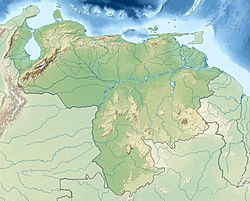Cerro Marahuaca facts for kids
Quick facts for kids Cerro Marahuaca |
|
|---|---|
| Highest point | |
| Elevation | 2,832 m (9,291 ft) |
| Prominence | 2,289 m (7,510 ft) |
| Listing | Ultra |
| Geography | |
| Location | Amazonas, Venezuela |
Cerro Marahuaca, also known as Marahuaka, is a special type of mountain called a tepui. Tepuis are like giant, flat-topped mountains with very steep sides. This one is located in the Amazonas state of Venezuela.
Cerro Marahuaca stands at 2,832 metres (9,291 ft) above sea level. This makes it the second-highest mountain in the entire Guayana Shield. The Guayana Shield is a very old and stable part of the Earth's crust in northeastern South America.
Cerro Marahuaca shares its base with another much larger tepui called Cerro Duida. Together, they form a mountain group known as the Duida–Marahuaca Massif. Both of these amazing tepuis are found completely inside the Duida–Marahuaca National Park.
Cerro Marahuaca actually has two main flat areas at its top, like two separate plateaus. The northern plateau is a bit larger and is called Fufha or Huha by the Yekwana Native Americans.
The southern plateau has two local names. Its northwestern edge is known as Fuif or Fhuif. The southeastern part of this plateau is called Atahua'shiho or Atawa Shisho.
Close to these two plateaus, to the west, is a huge ridge called Cerro Petaca. It rises to at least 2,700 metres (8,900 ft) high.
In 1973, an Italian explorer named Walter Bonatti tried to climb Cerro Marahuaca but did not succeed. The first time someone successfully climbed Cerro Marahuaca was in 1984. Venezuelan climbers Luis Enrique (Kike) Arnal, Ramón Blanco, Manuel Guariguata, and José Luis Pereyra made it to the top using the mountain's Southwest face.
The flat top area of Cerro Marahuaca covers about 121 km2 (47 sq mi). The total area of its slopes is estimated to be around 325 km2 (125 sq mi).
Flora and fauna
The top of Cerro Marahuaca is home to several unique frog species. These frogs are found nowhere else in the world! Some examples include Pristimantis marahuaka, Metaphryniscus sosai, and Myersiohyla inparquesi. Scientists continue to study the amazing plants and animals that live on these isolated tepuis.
See also
 In Spanish: Cerro Marahuaca para niños
In Spanish: Cerro Marahuaca para niños
- Distribution of Heliamphora
- List of Ultras of South America


